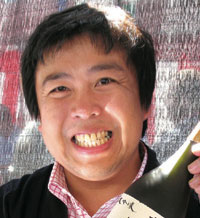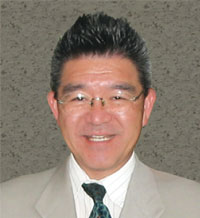Tokyo Jizake Strolling (A Stroll to the Shibamata Taishakuten Temple: Part 2)
By Ryuji Takahashi
The last report detailed my visit to the Shibamata Taishakuten Temple. This report describes my visit from Edogawa to the Tora-san Memorial Museum in the Katsushika-Shibamata area. Going around the back of the Taishakuten Temple down a short walk leads to Edogawa (the Edo River). Rapeseed flowers covered the riverbanks with many cherry blossoms still blooming. The blue sky, yellow rapeseed flowers, and pink cherry blossoms were beautiful, reminiscent of the riverbank in the opening scene of the film, “Otoko Wa Tsurai Yo” (“It’s Tough Being A Man”).
I wanted to ride the Yakiri ferry boat crossing that travels down the Edo River to Chiba prefecture and back. Time was unfortunately limited, so I headed to the Tora-san Memorial Museum instead. A movie set of the entrance and inside of the Kurumaya dumpling shop were recreated inside the museum, where fans always take a photo. A black phone suddenly rings inside the shop. When lifting the receiver, Tora-san’s voice is heard from the other end to enjoy a conversation as if you were Sakura (Tora-san’s half-sister) or Oi-chan (uncle and younger brother of Tora-san and Sakura’s father).
I wanted to ride the Yakiri ferry boat crossing that travels down the Edo River to Chiba prefecture and back. Time was unfortunately limited, so I headed to the Tora-san Memorial Museum instead. A movie set of the entrance and inside of the Kurumaya dumpling shop were recreated inside the museum, where fans always take a photo. A black phone suddenly rings inside the shop. When lifting the receiver, Tora-san’s voice is heard from the other end to enjoy a conversation as if you were Sakura (Tora-san’s half-sister) or Oi-chan (uncle and younger brother of Tora-san and Sakura’s father).
In the back, Tako Shacho’s Asahi Print Shop is recreated, where visitors can view the inside of an old print factory. The following booth is a miniature recreation of an old street in the Shibamata neighborhood, where the Kurumaya dumpling shop, the living room, the floor plan of the second floor, and the bathroom - each difficult to view in detail in the movie - are all visible on a model. Further ahead is the Shibamata Railway Station building, in front of which a red phone is visible in a public phone booth at the front. When you call a certain number, the call connects to the Kurumaya dumpling shop, where you hear the voices of Sakura, uncle, and auntie. A visitor can’t help but sense the sadness in bidding farewell to your family to leave on a trip.
Afterwards, an exhibit showed the contents in the cargo space of Tora-san’s car and his belongings he always carried with him. I was surprised to learn that Tora-san’s watch was a vintage Seiko Divers. After I took in the full view of the movie set, I headed to the Yamada Yoji Museum, where his past work, cameras, and films were displayed. It was around noon when I finished visiting the Shibamata Taishakuten Temple and the Tora-san Memorial Museum, so I headed down the Taishakuten-Sando (approach to the Shibamata Taishakuten Temple).
I thought of enjoying sake, yet the Shimabara neighborhood is a place to enjoy sweet dumplings, so I headed to Toraya instead. I had to wait a bit since it was noon but finally savored the long-awaited Mugwort dumplings. Sweets call for sake. The sake brand was not listed on the menu, which I guessed to be Takashimizu. The subtle sweet flavor of Mugwort dumplings paired perfectly with the sweet sake flavor. Afterwards, I went to a local Chinese eatery Shinkarou to satisfy my hunger. Although their lunch hours appeared to be over, the staff kindly invited me in. I ordered a bottle of beer, gyoza, and Stir-fried Pork Liver with Chinese Chives, very flavorful and satisfying. Of course, I headed back to the Taishakuten-Sando and went into another eatery. The Shibamata neighborhood I had visited since the morning was a wonderful place to reminisce down memory lane.
東京地酒散歩(柴又散歩 その2)
前回、柴又帝釈天に行った話を書いたのだが、今回は江戸川から葛飾柴又寅さん記念館までの話となる。帝釈天の裏手に回り少し歩くと江戸川に出る。江戸川は菜の花が咲き、まだ桜も残っていて、空の青と菜の花の黄色と桜のピンクがとてもステキで、男はつらいよの映画で見たオープニングの土手は健在だった。千葉県へと江戸川を行き来する矢切の渡しも乗ってみたかったが、時間の都合もあるので諦め、寅さん記念館へ。記念館の中は、映画のセットが再現されており、くるまやの団子屋の入り口から内部までリアルに再現されており、ファンなら必ず写真を撮りたい場所である。そしてその店内には黒電話があり、突然電話が鳴るのだが、受話器を取ると寅さんからの電話で、さくらやおいちゃんの気持ちになって会話を楽しむことが出来る。
ちゃんと裏手にはタコ社長の朝日印刷所が再現されており、昔の印刷工場の内部も見ることが出来る。その後のブースは昔の柴又の街をミニチュアで再現した場所で、映画では解りにくいくるまやの店舗や居間、2階の間取りや厠の場所まで模型で学ぶことが出来た。その先は寅さんが旅に出る柴又駅の駅舎の前に公衆電話の赤電話が置いてあり、ある番号に電話をかけると、くるまやに電話が繋がり、さくらやおいちゃんおばちゃんの声が聞ける。家族に別れを告げ旅に出る寂しさを感じることが出来るのである。
その後は展示で寅さんのトランクの中身や常に身に着けている物を見ることが出来た。腕時計は年期物のセイコーのダイバーズだったことに驚いた。ひと通り映画の中の世界を満喫した後は、山田洋次ミュージアムへ。過去の作品やカメラやフィルムを見学することが出来る。そして、帝釈天と寅さん記念館を巡り、ちょうどお昼を回った頃なので、帝釈天参道へ。
どこで酒を飲もうかなと考えたが、やはり柴又は団子屋だろうということで、とらやへ。昼時ともあって少し並んで待ったが、待望の草団子を食べることが出来た。甘味にはやはり日本酒。メニューには銘柄は書いていなかったが、どうやら高清水の様だ。草団子の上品な甘味と酒の甘味がピッタリマッチする。その後、物足りない腹を満たしに気になっていた町中華の新華楼へ。もう昼営業が終わりの雰囲気だったが快く招き入れてくれた。瓶ビールと餃子とレバニラを注文して食べたが、なかなかのレベルの高い味わいで大満足。当然参道に戻ってもう1軒言ったのだが、朝からの柴又はノスタルジックな思い出に浸れる素晴らしい場所だった。




